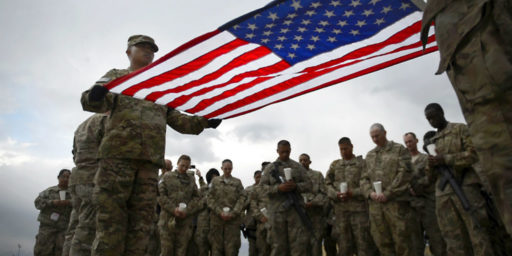AFGHANISTAN AND THE TOOTH:TAIL RATIO
Robert Kaplan is beating his favorite drum:
Two years ago this month, fewer than 100 men of the Army’s Fifth Special Forces Group, based out of Fort Campbell, Ky.–almost all of them noncommissioned officers–essentially took down the Taliban regime on their own. Along with a handful of Air Force special-ops embeds, they succeeded where the British and the Soviets before them in Afghanistan had failed, because they had been given no specific instructions. The bureaucratic layers between the U.S. forces and the secretary of defense were severed. They were told merely to link up with the “indigs” (indigenous Northern Alliance and friendly Pushtun elements) and make it happen.
The result was that they grew beards and rode horses from one redoubt to the next, even as their team sergeants called in air strikes without first seeking written approval. Because Fifth Group was allowed to operate independently of the vertical, Industrial Age hierarchy of the Pentagon, and because it combined 19th-century warfare with 21st-century close air support, the Fifth Group achieved the very postindustrial military “transformation” that elites in Washington are incessantly talking about, but don’t seem to understand–because real transformation, which involves the dilution of central control, would make many of these elites themselves redundant.
But now, military transformation is receding behind us in Afghanistan. With Saddam Hussein in custody, the Pentagon is focusing on the capture of Osama bin Laden, who may be in the Afghanistan-Pakistan border area. Yet success against bin Laden means going back to what we did right two years ago.
Of the roughly 10,000 American troops in Afghanistan, only a fraction of them are doing anything directly pivotal to the stabilization of the country. The rest are either part of a long support tail or part of newly created layers of command at Bagram Air Base, north of Kabul, which micromanage and complicate the work of a relatively small number of Army special forces troops (Green Berets) located at various “fire bases.”
Instead of powering down to a flattened hierarchy of small, autonomous units dispersed over a wide area–what the 1940 Marine “Small Wars Manual” recommends for fighting a guerrilla insurgency–we have barricaded ourselves into a mammoth, Cold War-style base at Bagram that drains resources from the fire bases. It is ironic that just as the Pentagon is proposing a more light and lethal world-wide basing posture (with many smaller footprints rather than a few large ones in Korea and Europe), in Afghanistan, whose mountains and tribes make it the most unconventional of battlefields, we have reverted to such an antiquated arrangement.
It’s worth reading the whole column. While I think devolving strategic decision-making down to the NCO level is more problematic than Kaplan acknowledges, flexibility is certainly necessary for this type of operation.





Of course, another interpretation was that two very, very very large late 20th-century logistics-heavy organizations, called the US Air Force and the US Navy, provided at least 99% of the fire power. From very large bases in the Persian Gulf, and from very large fleets of ships in the Indian Ocean.
Without them those 100 men would have been swallowed up by Afghanistan, as so many were before.
Also, that these two organizations had incredibly elaborate planning apparati, to get that on-call[1] fire support overhead.
As to what was accomplished – from my understanding, post Soviet invasion Afghanistan was best described as ‘howling chaos’, even by historical standards in Afghanistan. The Taliban were able to come out on top because they could put an end to this. The US campaign knocked them off of the top of the heap, after they had pissed away a lot of goodwill.
The post-war story has been pretty much one of Taliban resurgence, taking back Afghanistan one province at a time. Largely because we doesn’t have enough ground forces to hold Afghanistan. And probably don’t want to try, with or without the Iraq war, because that’s been what’s caused trouble for invaders before – after all, the Soviets moved in quite swiftly in 1979.
This means that the new government is really composed of warlords – the same ones which the Taliban defeated, or who were with the Taliban, when they were on top. Which means that they’ll play with today’s winner. Unless, of course, they can play ‘screw the ignorant foreigner’.
So right now, it looks like the US was able to temporarily shift the balance of power in Afghanistan, somewhat, for a couple of years.
That’s all.
Barry
[1] I read somewhere that the shortest time from calling for air support to getting it was 45 minutes, in the whole campaign. That’s the shortest time out of hundreds, so the Air Force definition of ‘on-call’ still isn’t the grunt’s definition.
—